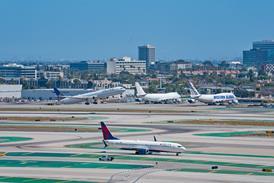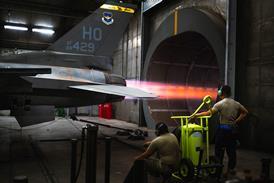New models crowd market as business jet boom goes on
Kate Sarsfield/BUSINESS & GENERAL AVIATION EDITOR
The mood throughout the general aviation industry is bullish. Faced with record order backlogs from an expanding and diversified customer base, manufacturers are swelling production and completion facilities to keep pace with demand. The immediate concern faced by the industry appears to be recruiting and retaining enough skilled technicians to satisfy delivery schedules and so shorten the lead time for availability which, for business aircraft customers, can stretch to two years.
Latest statistics from the US General Aviation Manufacturers Association (GAMA) reveal third quarter billings at just over $2 billion, which is the best third quarter in history for US manufacturers. GAMA says the 684 aircraft shipped was an increase of 13% on the same period the previous year and the highest third-quarter level since 1984.
Turboprop deliveries through the first nine months of last year were up by 36% to 233 units, while jet deliveries totalled 431 units, a 15% gain. Shipments of piston-engined aircraft increased by 13.8% to 1,366 units.

Bombardier retains its lead in value terms, having delivered more than 160 aircraft in the first nine months, up from 128 during the same period in 1999. Learjet 45 deliveries alone increased 50%. Cessna, the market leader in unit terms, saw a 19% hike in Citation deliveries, from 148 to 176 units, stimulated by the service entry of its CJ1, CJ2 and Encore.
Raytheon, too, is seeing strong demand for its varied product line, having matched its 1999 total by the end of the third quarter. The company - essentially a defence manufacturer - may be hoping that demand for its expanding product line will attract a suitable buyer for its Raytheon Business Aircraft unit, which is understood to be up for sale.
As manufacturers work off order backlogs, production will slow. In its ninth annual forecast, engines and avionics supplier Honeywell predicts that business aircraft deliveries have already peaked - at 2000's 740. In the next year, the report says, deliveries will drop to 698 aircraft, then fall again to 600 aircraft, before climbing at the end of the decade. Honeywell predicts that during the span of its forecast period, 2001-2011, around 6,800 new business jets will be delivered, worth more than $90 billion.
In a customer-driven sector, manufacturers are striving to exploit market niches and introduce new, cost-effective, low-maintenance aircraft or upgrades to stimulate and retain demand. Last year, Raytheon launched its superlight Hawker 450 in line with its strategy of expanding and revamping its product line. The 450 will compete with the Bombardier Learjet 45 and Cessna Citation Excel, and will fit between Raytheon's light Beechjet 400A and mid-size Hawker 800XP. Wichita-based Raytheon is also replacing the 800XP standard Honeywell SPZ-8000 avionics system with the Rockwell Collins ProLine 21 as standard on the entry level Premier I, for which it hopes to finally gain US certification in the first quarter.
Gulfstream plans to fly its long-range GV-SP in the fourth quarter. The aircraft, which will replace the current GV, will compete against the Bombardier's newer, faster Global Express and will pave the way for the smaller GIV to be moved upmarket.
Dassault last year raised the stakes in the increasingly competitive large cabin aircraft market by introducing an upgraded version of its Falcon 2000. The Falcon 2000EX will be offered with 7,000lb-thrust (31.1kN) Pratt &Whitney PW308C engines, a 25% increase in range, to 7,030km (3,800nm) at Mach 0.8, and will be capable of non-stop flights between Europe and the US east coast. It is simply a matter of time before Bombardier pitches in with a revamped Challenger 604 (possibly named the 605) to compete head to head with the 2000EX.
Bombardier is also on target to fly its super mid-size Continental business jet in April, which when finally certificated in 2002 will be the second super mid-size to enter the market. Super mid-size pioneer Galaxy Aerospace plans to announce the result of a customer survey that should determine the future of the Galaxy/Israel Aircraft Industries product line. Cessna, meanwhile, is increasing the gross weight and thrust of the Citation X to distance itself from the emerging range of super mid-size aircraft.
Cessna and rival New Piper are studying options for new aircraft at the lighter end of their ranges. Cessna is looking at three options for an aircraft to fill the gap between its largest piston single, the 206 Stationair, and its smallest twinjet, the CJ1. New Piper, having just certificated the single-turboprop Malibu Meridian and with an upgraded Malibu Mirage high-performance piston single which enters production next year, plans to revamp its light aircraft range, from the Warrior trainer to the six-seat Seneca. Fuelled by advanced propulsion technology, the aircraft could be unveiled this year.
Cessna will add two models to its thriving piston single line this year. The 182T Skylane and T182T Turbo Skylane will have redesigned wingtips, restyled and relocked main gear fairings and an improved nose gear fairing, a low drag wing strut fairing and streamlined refuelling system and entrance steps.
Independent light aircraft manufacturers Lancair and UK Liberty Aircraft are hoping to gain approval this year for their turbocharged Columbia 400 and two-seat XL-2 light aircraft, a certificated derivative of the Europa kit plane.
The helicopter market remains buoyant with increasing orders from the law enforcement, emergency medical services and corporate markets, but much activity behind the scenes is aimed at bringing the latest generation of machines to the market. Bell/Agusta Aerospace plans to begin final assembly of its BA609 tiltrotor in March and commence flight testing in November. Sikorsky plans to fly a final pre-production S-96 early this year year with new avionics, enlarged fuselage and reconfigured tail, in preparation for certification in 2002.
The e-commerce revolution has swept through the general aviation industry in the past 12 months as manufacturers, no longer content with just building and selling aircraft, strive to offer customers a new medium for accessing aircraft. Bombardier took the lead last year to become the first business aircraft giant to offer customers "one-stop shopping" on the internet. The e-business initiative, scheduled for launch in the first quarter, will offer "virtually every aspect of the company's corporate activities" online, says Bombardier, including aircraft sales, maintenance, servicing, fractional ownership (still booming) and charter.
Bombardier's acquisition of online charter reservation pioneer Skyjet.com last year started a wave of consolidation in the online charter market, which is likely to continue as manufacturers and first-tier charter companies such as Raytheon Aircraft Charter and Management and Executive Jet enter the market.
Independent online companies, such as FlightTime.com, Indigo, FlightServ and eJets.com, will seek to develop their distinctive brands. Industry players see huge potential for online activity in the USA and plan to cast their nets wider, with Europe next in line.
Source: Flight International




















